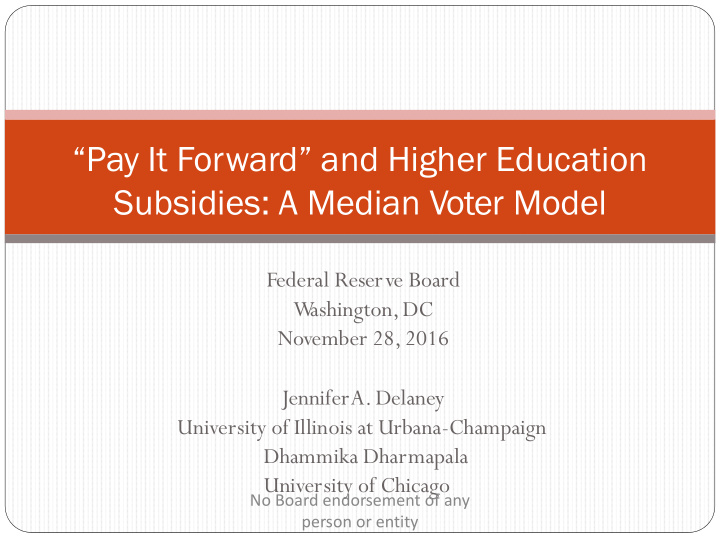



“Pay It Forward” and Higher Education Subsidies: A Median Voter Model Federal Reserve Board W ashington, DC November 28, 2016 Jennifer A. Delaney University of Illinois at Urbana-Champaign Dhammika Dharmapala University of Chicago No Board endorsement of any person or entity
Background Student loans address capital constraints for user charges for higher education. Costs for higher education are shared between students, governments, and donors (especially at private institutions). Under cost-sharing, the amount of subsidy provided by governments (and donors) shapes price levels charged to students. These price levels shape the need for student loans. Our piece considers what happens to government subsidies for public higher education under different types of pricing structures. No Board endorsement of any person or entity
Current Up-front Tuition Model The current higher education pricing model with up- front tuition assumes intergenerational transfer . Parents are expected to pay for their children’ s education. Students who do not have parental financial support are more likely to need to borrow from future earnings to pay for college ( i.e. take out student loans). Changing the mechanics of user-charges for higher education has the potential to shift the assumptions about which generation pays for college. Better alignment with today’ s reality for most students. No Board endorsement of any person or entity
“Pay It Forward” Pay It Forward (PIF) models enable students to pay the price of college upon departure from an institution, as opposed to paying upfront tuition. Since 2013, at least 24 states have considered legislation on PIF models of higher education finance. No Board endorsement of any person or entity
PIF Legislation in the US States No Board endorsement of any Source: National Association for College Admissions Counseling . (2015) What is “Pay It Forward?” http://www .nacacnet.org/issues- person or en tity action/LegislativeNews/Pages/Pay-It-Forward.aspx (accessed 11/1/2015).
“Pay It Forward” Our paper develops a median voter model of higher education subsidies under PIF policies. Uses a framework in which voters belonging to different income groups vote over the level of subsidies to higher education. We analyze the impact of two facets of potential PIF policies on college access and on voting equilibria over subsidy levels: Deferred tuition approach. Income share approach. No Board endorsement of any person or entity
Fernandez and Rogerson (1995) Model The FR model derives the outcomes of a majority voting political process over the extent of subsidies to higher education and addresses central issues of efficiency and equity in higher education. Upfront T uition A subsidy ( s ) to higher education lowers the cost to students to ( E – s ) H What level of subsidy will be M chosen through majority voting? Both High and Low may favor a low L subsidy: High does not need subsidies… No Board endorsement of any few members of Low attend college. person or entity
PIF Model – Deferred Tuition Enhances access, as credit constraints become irrelevant. 3 Income Groups Subsidies may still be enacted for Deferred T uition redistribution. H chosen through majority voting? Key factor: does M’ s income exceed the mean income in society? M Subsidies may increase, decrease or tuition. L Low now attends college, so favors subsidies (which will be enacted whenever Middle and Low both favor them). No Board endorsement of any person or entity
PIF Model – Income Share Enhances access, as credit constraints 3 Income Groups become irrelevant. Graduates pay a Subsidies may still be enacted for share of income not redistribution. directly related to E What level of subsidy will be chosen H 𝑔 𝑔 ( 𝑧 𝑗 ) > Key factor: 𝑧 𝑗 𝜈 Depends on how higher education affects M the distribution of income. the relative distribution of income… L but not if college widens the relative distribution of income. No Board endorsement of any person or entity
Extensions Add risk-aversion and uncertainty Payoff from college attendance is a random variable. Multidimensional heterogeneity In addition to heterogeneity in income, “ability” may differ within an income group. Endogenous choice of taxes on post-college incomes Second-period taxes are chosen in political equilibrium, potentially affecting the after-tax payoff from college. In general, results on voting outcomes are quite robust, albeit with some modifications to the conditions required. No Board endorsement of any person or entity
Deferred Tuition and College Completion: Cross-National Comparisons Deferred Tuition Up-front Tuition Australia Austria New Zealand Bulgaria United Kingdom Costa Rica Indonesia Italy Japan Malaysia Mongolia Netherlands Spain Switzerland Turkey No Board endorsement of any United States of America person or entity
Gross Tertiary Graduation Ratio 2010, by Type of Tuition Fee 70 60.1 Deferred 60 tuition 47.7 45.0 45.1 50 42.2 40.8 41.1 28.9 29.9 30.6 34.0 35.0 37.8 40 Up-front tuition 30 22.9 14.6 17.8 20 10 0 • In general, nations with deferred tuition polices have higher gross graduation ratios than nations with upfront tuition policies. • All nations with deferred tuition policies have higher ratios No Board endorsement of any than the US. person or entity
Conclusions Important distinctions between a deferred tuition model and an income share model. Important increases in college access can be achieved with either type of deferred tuition system. In many of the voting equilibria of our model, changing from an up-front tuition system will not result in a decline of government subsidy values. More discussion is needed in both the policy and academic communities about the type of tuition system used in the US. No Board endorsement of any person or entity A i l f d l f
Jennifer A. Delaney delaneyj@Illinois.edu Full paper available: Jennifer Delaney and Dhammika Dharmapala, 'Pay It Forward' and Higher Education Subsidies:A MedianV oter Model SSRN: https://ssrn.com/abstract=2518248 No Board endorsement of any person or entity
Recommend
More recommend